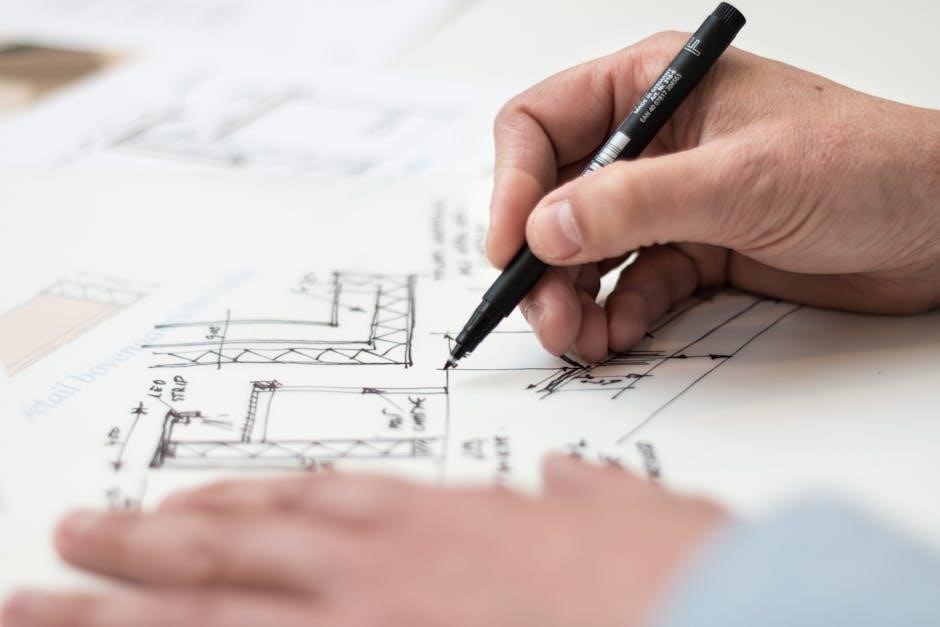
blueprint trailer plans pdf
Blueprint Trailer Plans PDF provides detailed designs and guides for constructing trailers, offering comprehensive layouts, material lists, and step-by-step instructions for both DIY enthusiasts and professionals.
What Are Blueprint Trailer Plans?
Blueprint trailer plans are detailed schematic drawings that outline the structural design, dimensions, and components of a trailer. They provide a visual guide for constructing or modifying trailers, ensuring accuracy and compliance with safety standards. These plans typically include measurements, material specifications, and assembly instructions, catering to both professional builders and DIY enthusiasts. By following these plans, individuals can create custom trailers tailored to their specific needs, whether for utility, recreational, or commercial purposes.
Why Use PDF Format for Trailer Plans?
The PDF format is ideal for trailer plans due to its universal compatibility, clarity, and security. PDFs maintain high-resolution images and text, ensuring detailed designs are easily readable. They can be accessed on any device, making them convenient for builders. Additionally, PDFs are often free, eco-friendly, and can be shared without losing quality. This format is widely preferred for blueprints as it supports zooming for precise details and printing without distortion, making it a practical choice for both professionals and DIY enthusiasts.
Key Components of a Trailer Blueprint
A trailer blueprint includes detailed dimensions, a materials list, frame layout, axle placement, wiring diagrams, and assembly instructions, ensuring a clear guide for construction.
Understanding the Layout and Design
Trailer blueprints provide a visual representation of the trailer’s structure, including plan views, elevations, and section details. These layouts help users understand the spatial relationships between components, ensuring accurate construction. The design often includes labeled measurements, material specifications, and assembly instructions, making it easier to visualize and execute the build. Understanding the layout and design is crucial for ensuring the trailer meets functional and safety requirements, while also allowing for customization to suit specific needs.
Essential Elements of Trailer Plans
Trailer plans include detailed dimensions, material specifications, and structural blueprints. They outline the frame, axle placement, and wiring layout, ensuring stability and safety. The plans also specify essential components like braking systems, lighting, and coupling mechanisms. Additionally, they may cover weight distribution, load capacity, and towing requirements. These elements ensure the trailer is functional, durable, and compliant with safety standards, while also allowing for customization to meet individual needs and preferences.
Types of Trailers and Their Blueprints
Trailer blueprints vary by type, including utility, RV, and custom designs. Each blueprint caters to specific needs, ensuring functionality and durability through detailed engineering and customizable features.
Utility Trailer Plans
Utility trailer plans are designed for hauling heavy loads, featuring durable frames and open beds. They often include customizable axle options, payload capacities, and coupler types. These plans cater to agricultural, construction, or recreational needs, emphasizing simplicity and strength. The blueprints typically detail materials, dimensions, and assembly steps, ensuring sturdy construction. Whether for transporting equipment or landscaping supplies, utility trailer plans provide practical solutions for various tasks, making them a versatile choice for DIY builders and professionals alike.
RV and Camping Trailer Plans
RV and camping trailer plans offer detailed blueprints for constructing recreational vehicles, focusing on comfort and functionality. These designs include layouts for compact travel trailers, pop-up campers, and motorhomes, often featuring kitchenettes, sleeping quarters, and storage solutions. The plans emphasize lightweight materials and space efficiency, catering to adventurers seeking affordable, customizable options. Whether for weekend getaways or extended trips, RV and camping trailer plans provide the framework for building a home away from home, tailored to diverse outdoor lifestyles and preferences.
Custom and Specialty Trailer Plans
Custom and specialty trailer plans cater to unique needs, offering tailored designs for specific purposes like food trucks, horse trailers, or luxury RVs. These blueprints often include intricate details such as customizable interiors, advanced storage solutions, and specialized features. Ideal for individuals or businesses requiring unique solutions, custom trailer plans provide flexibility and precision, ensuring the final product meets exact specifications. They are perfect for those seeking trailers that stand out in functionality and design, reflecting personal or professional requirements.

Choosing the Right Trailer Size and Design
Selecting the right trailer size and design involves assessing your needs, such as cargo type and weight, ensuring compatibility with your vehicle’s load capacity and towing capacity.
Matching the Trailer to Your Needs
Assessing your specific needs is crucial when selecting a trailer. Consider the intended use, such as hauling large items, transporting vehicles, or carrying equipment. Evaluate the cargo type, weight, and size to ensure the trailer’s capacity matches your requirements. Additionally, consider your vehicle’s towing capacity and the frequency of use. Whether for personal projects or commercial purposes, aligning the trailer’s design with your lifestyle and workload ensures optimal performance and durability over time.
Factors to Consider in Trailer Design
When designing a trailer, key factors include durability, weight distribution, and safety features. Materials like steel or aluminum should be chosen for strength and longevity. Consider the axle type, suspension, and braking system to ensure stability and control. Additionally, think about storage capacity, loading mechanisms, and tie-down points for secure cargo transport. Always adhere to local regulations and safety standards to avoid legal issues and ensure the trailer is roadworthy for its intended purpose.

Legal and Safety Considerations
Ensure compliance with local regulations and safety standards when building trailers. Use durable materials and follow construction practices to guarantee safe and legal operation of the trailer.
Permits and Regulations for Trailer Construction
Before constructing a trailer, ensure compliance with local building codes and safety regulations. Obtain necessary permits and approvals from authorities to avoid legal issues. Trailer blueprints must meet specific standards for structural integrity and safety. Environmental impact assessments may also be required. Familiarize yourself with DMV requirements for trailer registration and roadworthiness. Proper documentation and adherence to regulations ensure your trailer is legally compliant and safe for use.
Safety Tips for Building and Using Trailers
Always wear protective gear like gloves and safety glasses during construction. Follow the blueprint instructions precisely to ensure structural integrity. Regularly inspect the trailer for wear and tear, especially the brakes and tires. Load cargo evenly to maintain balance and prevent swaying. Never exceed the trailer’s weight capacity. Use proper hitching techniques and ensure all lights are functional before towing. Keep emergency tools like a fire extinguisher and spare tire on board. Prioritize safety to avoid accidents and ensure smooth operation.
Tools and Materials Needed
Essential tools include welders, saws, and drills, while materials like steel, wood, and metal framing are required. Always use durable components to ensure safety and longevity.

Essential Tools for Trailer Construction
Key tools include MIG welders for metal joints, circular saws for cutting wood or metal, and impact wrenches for tightening bolts. Measuring tools like tape measures and squares ensure accuracy. Safety equipment such as gloves and goggles is crucial. Power tools like drills and grinders are also necessary. Additionally, trailer-specific tools like axle alignment kits and brake testers may be required. Having the right tools ensures a safe and efficient building process, adhering to the blueprint’s specifications.
Recommended Materials for Durability
Steel frames and galvanized coatings provide strength and rust resistance. Aluminum is lightweight and corrosion-resistant, ideal for trailer bodies. Pressure-treated wood or marine-grade plywood is recommended for flooring. High-strength steel axles and leaf springs ensure durability under heavy loads. Wheels and tires should be heavy-duty, suitable for the intended use. Stainless steel or zinc-coated hardware resists rust. Sealants and protective coatings shield against environmental damage. Using these materials ensures a long-lasting and reliable trailer, aligning with the blueprint’s specifications for durability and performance.

DIY vs. Professional Construction
DIY construction saves costs but requires time and skills, while professional building ensures reliability and quality, though at a higher expense, depending on your expertise and resources.
Pros and Cons of Building Your Own Trailer
Building your own trailer offers cost savings, customization, and a sense of accomplishment. However, it demands time, skills, and tools. DIY can be rewarding but may lead to safety risks if construction isn’t up to standard. Proper planning and adherence to blueprints are crucial to avoid costly mistakes and ensure durability. Balancing creativity with technical accuracy is key to a successful project. Research and preparation are essential for a positive outcome. Always follow safety guidelines and building codes.
When to Hire a Professional
Hiring a professional is advisable when dealing with complex trailer designs or when safety and structural integrity are critical. If you lack the time, skills, or tools to ensure a flawless build, experts can deliver high-quality results. They handle permits, materials, and construction efficiently, minimizing risks and ensuring compliance with regulations. Professionals are particularly recommended for large-scale or specialized trailers, where precision and expertise are essential for durability and performance. Their experience ensures a safe and reliable final product.
Where to Find High-Quality Trailer Plans PDF
Find high-quality trailer plans PDFs from trusted sources like specialized DIY websites, engineering forums, or verified marketplaces. Ensure plans are detailed and suitable for your project needs.
Reliable Sources for Downloading Plans
Reputable websites like DIY trailer forums, engineering platforms, and specialized marketplaces offer high-quality trailer plans. These sources provide detailed blueprints, ensuring accuracy and suitability for various projects. Always verify the credibility of the provider before purchasing or downloading plans to avoid low-quality or incomplete designs. Additionally, check for user reviews and certifications to ensure the plans meet your specific needs and conform to safety standards.
How to Verify the Quality of the Plans
Evaluating the quality of trailer plans involves checking for clear diagrams, detailed measurements, and comprehensive material lists. Ensure the plans are compatible with your skill level and local regulations. Look for reviews or testimonials from other users to gauge reliability. Additionally, verify if the plans include warranty information or customer support from the provider. High-quality plans should also offer step-by-step instructions and safety guidelines to ensure a successful build.
A well-crafted blueprint trailer plan ensures a successful, durable, and safe build, guiding you through every step with clarity and precision for optimal results.
Final Tips for Successful Trailer Building
Adhere to local regulations, ensure safety protocols, and use high-quality materials. Double-check measurements and follow the blueprint meticulously. Regular inspections and maintenance are crucial for longevity. Consider professional assistance if unsure about complex steps. Prioritize compliance with legal standards and test the trailer thoroughly before use to ensure reliability and safety.
Importance of Following the Blueprint
Following the blueprint ensures structural integrity, safety, and compliance with legal standards. Deviations can lead to unsafe conditions or legal issues. The blueprint provides precise measurements and material specifications, minimizing errors. It also guides proper assembly, ensuring the trailer withstands stress and load requirements. By adhering to the plan, you achieve a durable, functional, and reliable trailer that meets both practical and regulatory needs, guaranteeing optimal performance and longevity.